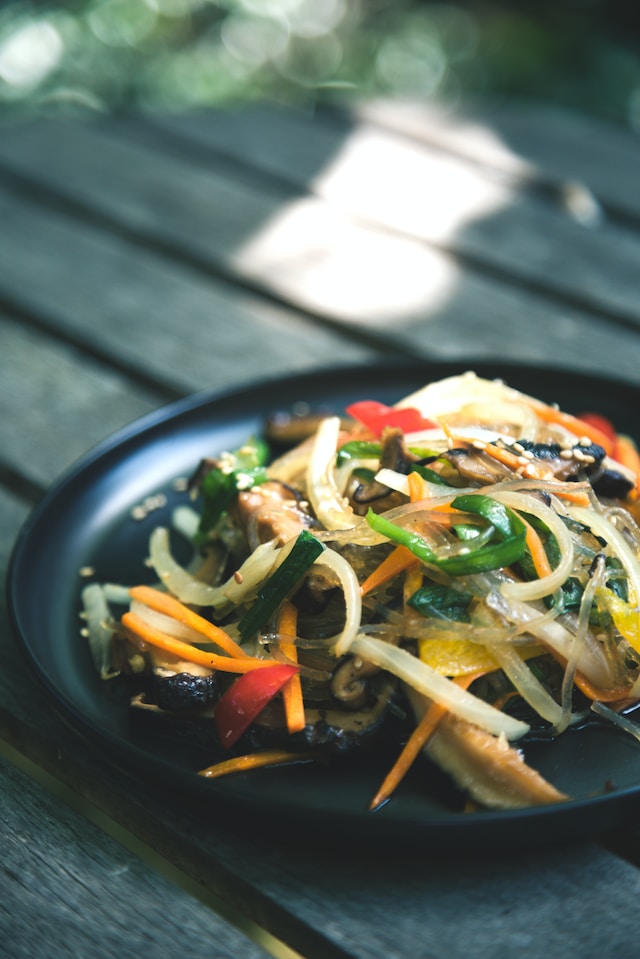
Stir-frying, a cooking method originating from the vibrant landscapes of Asia, has captivated the taste buds of food enthusiasts worldwide. This impeccable culinary technique involves quickly cooking ingredients in a hot oil-infused pan. The result? A symphony of flavors and textures that dance harmoniously together, leaving your palate begging for more.
This age-old Asian cooking method epitomizes simplicity and speed. Its techniques are rooted in practicality, making it a perfect addition to any home cook’s repertoire.
Stir-frying not only offers a delicious and wholesome meal but also retains the nutritional value of the ingredients due to its short cooking time.
The beauty of stir-frying lies in its ability to effortlessly combine various elements. Whether it be the succulent slices of meat, vibrant vegetables bursting with color, or a melody of aromatic spices, each ingredient retains its individual essence, while still contributing to a splendid collective experience.
The Basics of Stir-Frying
There is an art to perfecting the technique of stir-frying, and it all begins with the proper preparation and execution. By mastering the basics, you will embark on a culinary journey that will elevate your cooking skills to new heights.
1. The Pan: One of the essentials for stir-frying success is selecting the right pan. A wok, with its deep, sloping sides and wide surface area, is the traditional vessel for stir-frying. It allows for even heat distribution and quick cooking. However, if you don’t have a wok on hand, a large, flat-bottomed skillet will suffice.
2. Heat: The key to successful stir-frying lies in the intensity of the heat. High heat is necessary to achieve the coveted “wok hei,” a smoky, slightly charred flavor that adds depth to the dish. However, keep in mind that the oil must reach its smoking point quickly without burning. To test if the pan is hot enough, simply sprinkle a few drops of water into the pan. If they sizzle and evaporate immediately, you are ready to start stir-frying.
3. Oil: A stir-fry is incomplete without a generous drizzle of oil. Its purpose is not only to prevent the ingredients from sticking to the pan but also to infuse them with its luscious flavors. Traditionally, oils with high smoke points like peanut or vegetable oil are preferred. You can also experiment with sesame oil to impart a nutty aroma.
4. Ingredients: The beauty of stir-frying lies in its versatility. Choose a combination of proteins, vegetables, and aromatic spices that appeal to your taste. It is important to cut them into uniform, bite-sized pieces to ensure even and quick cooking. Remember to separate dense vegetables, like carrots or broccoli, from delicate ones, such as snow peas or bean sprouts, to control the cooking time and maintain their distinct textures.
5. Stir-fry with Speed: As the name suggests, stir-frying is all about quick and constant movement. Arm yourself with a spatula or wok shovel and keep the ingredients in perpetual motion. This not only ensures even cooking but also prevents them from becoming mushy. A good stir-fry takes barely a few minutes, so have everything ready and within arm’s reach to maintain the rhythm and momentum.
6. Sauce: The final touch to a stir-fry is the sauce. A delicate balance of sweet, salty, and savory flavors, the sauce brings the dish together. Experiment with classic combinations like soy sauce, oyster sauce, ginger, garlic, and a touch of sweetness from honey or sugar. Be creative, and adjust the flavors to your liking.
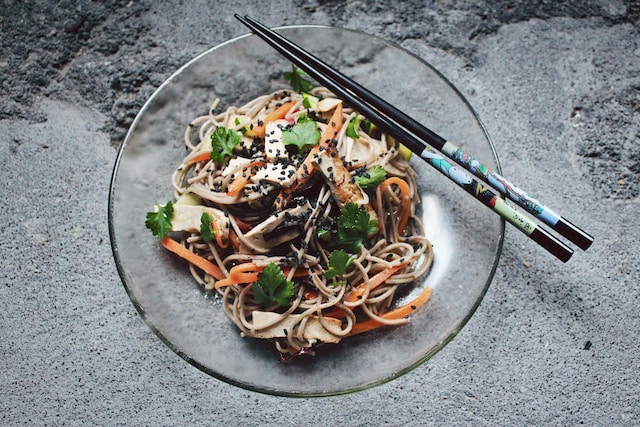
Health Benefits of Stir-Frying
The art of stir-frying not only delights the taste buds but also offers an array of health benefits. The brief cooking time and minimal use of oil in this technique help to retain the natural goodness of the ingredients, ensuring that each bite is packed with vitamins, minerals, and antioxidants. Here are a few reasons why incorporating stir-frying into your cooking routine can contribute to your overall well-being:
- Retains Nutritional Value: With stir-frying, the vegetables and proteins maintain their vibrant colors and crisp textures, preserving their nutrient content. Unlike boiling or braising, which can cause vital nutrients to leach into the cooking liquid, stir-frying ensures that these nutrients are retained, offering you a wholesome and nourishing meal.
- Promotes Balanced Diets: Stir-frying encourages the inclusion of a wide variety of vegetables, proteins, and spices in each dish. This diversity not only enhances the flavors but also provides a balanced mix of essential nutrients. From the fiber-rich cruciferous vegetables like broccoli and cauliflower to the lean proteins like chicken or tofu, each ingredient contributes to a well-rounded and nutritious meal.
- Reduced Fat Intake: Due to the quick cooking process and minimal use of oil, stir-frying helps reduce the overall fat content of the dish. By using a small amount of high-smoke point oil and a fast cooking time, you can enjoy the delectable flavors without excessive added fats. This makes stir-frying ideal for those who want to maintain a healthy weight or reduce their fat intake.
- Increased Vegetable Consumption: Stir-frying is a fantastic way to increase your vegetable intake. By tossing a medley of colorful vegetables into the hot pan, you can easily incorporate a variety of nutrients into your meal.
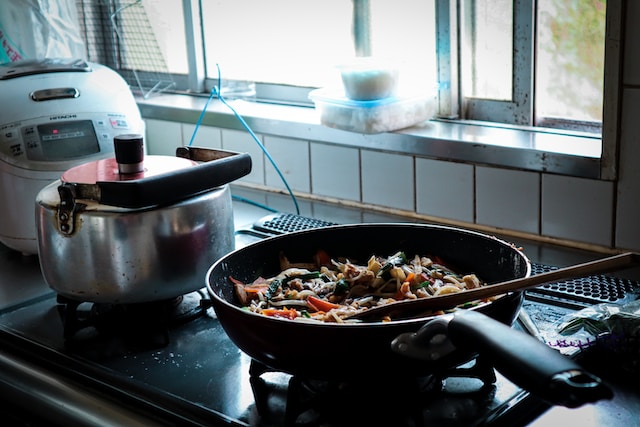
The combination of vibrant vegetables adds flavor, texture, and essential vitamins and minerals to your diet, promoting overall well-being.
- Digestive Health: The quick cooking process in stir-frying helps to retain the crispness and natural enzymes present in the vegetables. These enzymes aid in digestion and promote a healthy gut. Additionally, the high heat used in stir-frying can help break down fibers, making them easier to digest and absorb.
Stir-Frying Techniques
Stir-frying is an art that requires both technique and finesse. By mastering these simple yet effective stir-frying techniques, you will be able to create dishes that burst with flavor and texture.
Searing
Before you start stir-frying, it is crucial to sear the protein or meat you are using. This technique locks in the juices and enhances the overall taste. Begin by heating the pan until it is scorching hot. Then, add a small amount of oil and swirl it around to coat the surface. Once the oil starts to shimmer, carefully add the protein and let it sear for a few minutes on each side until it develops a beautiful golden crust.
Slide and Flip
To ensure even cooking and prevent sticking, it is important to continuously slide and flip the ingredients in the pan. Use a spatula or wok shovel to gently push the ingredients around, moving them from the edges to the center and vice versa. This constant motion distributes the heat evenly and ensures that each piece cooks to perfection.
Steam Infusion
As you stir-fry, you may encounter ingredients that require a little extra tenderness. To achieve this, add a splash of water or broth to the pan and cover it with a lid. This creates a steam infusion that lightly cooks the ingredients, ensuring they are both flavorful and tender.
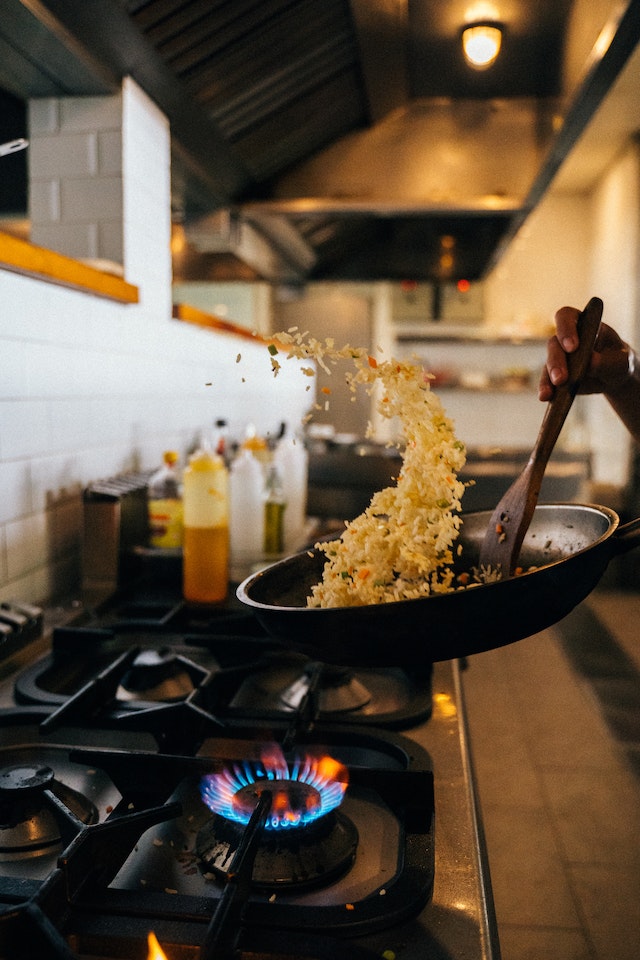
Tossing
Tossing is an essential technique in stir-frying, as it adds a fantastic visual element and ensures that the ingredients are thoroughly combined. To toss the ingredients, hold the handle of the pan firmly and give it a quick, flicking motion away from you, allowing the ingredients to jump and flip in the air. With practice, you will become skilled at this technique, creating a theatrical spectacle in your own kitchen.
Garnish and Serve
The finishing touch to any stir-fry is the garnish. Sprinkle fresh herbs, such as cilantro or Thai basil, over the dish to add a bright burst of color and fragrance. Squeeze a wedge of lime or lemon to add a tangy zest. Serve the stir-fry immediately, while it is still piping hot, to ensure that all the flavors and textures are at their prime.
Common Stir-Fry Ingredients
Stir-frying offers a plethora of possibilities when it comes to ingredient selection. Whether you prefer to create a vibrant vegetarian stir-fry or a meat-lover’s dream, there are countless options to suit every palate. Here is a list of some common stir-fry ingredients that you can experiment with:
Protein
- Chicken: Tender chicken breast or thigh, thinly sliced, is a popular choice for stir-fries. It cooks quickly and absorbs flavors beautifully.
- Beef: Choose lean cuts like sirloin or flank steak and slice them thinly across the grain for tender and tasty results.
- Pork: Tenderloin or boneless chops work well in stir-fries, offering a rich and savory element to the dish.
- Shrimp: Whether using large or small shrimp, they cook in a matter of minutes, adding a delightful seafood flavor to your stir-fry.
- Tofu: For a vegetarian or vegan option, firm tofu is an excellent choice. It readily absorbs the flavors of the sauce and provides a satisfying texture.
Vegetables
- Bell Peppers: Add a pop of color with red, green, or yellow bell peppers. They retain their crunch and bring a hint of sweetness.
- Broccoli: This nutrient-rich vegetable pairs well with various proteins and adds a lovely texture to the stir-fry.
- Carrots: Slice them diagonally to create thin and elegant carrot coins that provide a vibrant touch of orange.
- Snap Peas: Sweet and crisp, snap peas add a burst of freshness to any stir-fry. They can be enjoyed whole or lightly blanched.
- Mushrooms: Shiitake, cremini, or button mushrooms bring an earthy and rich flavor to a stir-fry. Slice them thinly for quick cooking.
Aromatic Spices
- Garlic: A foundational ingredient for any stir-fry, garlic adds a pungent and aromatic punch.
- Ginger: Freshly grated ginger provides a warm and spicy note that complements a wide variety of flavors. It also aids in digestion.
- Scallions: Chopped scallions, both the green and white parts, not only provide a fresh taste but also add a pop of green color.
Sauces and Seasonings
- Soy Sauce: A staple in Asian cuisine, soy sauce brings a savory and umami-rich flavor to the stir-fry.
- Oyster Sauce: Thick and syrupy, oyster sauce adds a depth of flavor and a hint of sweetness.
- Hoisin Sauce: This thick and fragrant sauce made from soybeans, garlic, spices, and vinegar provides a sweet and savory taste.
- Sesame Oil: A few drops of toasted sesame oil give a distinctive nutty aroma to a stir-fry. Use it sparingly as a finishing touch.
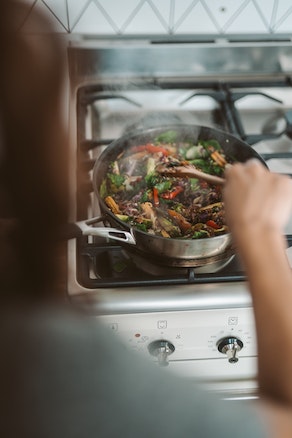
Tips for Successful Stir-Frying
1. Prepare all your ingredients ahead of time: Stir-frying happens quickly, so it’s essential to have everything ready to go. Chop your proteins and vegetables into uniform sizes, measure out your sauces and seasonings, and have them all within arm’s reach before you start cooking.
2. Ensure your pan is hot enough: The key to achieving that perfect stir-fry is a hot pan. Before adding any oil, preheat your pan over medium-high to high heat until it’s smoking slightly. This will ensure that your ingredients cook quickly and retain their vibrant colors and crisp textures.
3. Use the right oil: Choose an oil with a high smoke point for stir-frying, such as peanut, vegetable, or sesame oil. These oils can withstand high heat without burning, allowing you to achieve that coveted smoky flavor. Add the oil to the hot pan and swirl it around to coat the surface before adding your ingredients.
4. Cook in batches if necessary: Overcrowding the pan can lead to steaming rather than stir-frying. If you have a large quantity of ingredients, cook them in batches to maintain the high heat and ensure even cooking. Remove cooked ingredients from the pan and set them aside before adding the next batch.
5. Stir-fry in the right order: Start by stir-frying your proteins first, as they typically take longer to cook. Once they’re almost done, remove them from the pan and set them aside. Then, stir-fry your vegetables in the order of their density, adding the denser ones first and the more delicate ones towards the end. This will ensure that all the ingredients are cooked to perfection.
6. Season strategically: Add your sauces and seasonings towards the end of the stir-frying process, just before adding the cooked proteins back into the pan. This will allow the flavors to meld together without overpowering the natural taste of the ingredients.
7. Keep it moving: Stir-frying is all about constant movement. Use a spatula or wok shovel to toss and flip the ingredients quickly and continuously. This will help distribute the heat evenly, prevent sticking, and ensure that everything cooks evenly.

8. Taste as you go: Don’t be afraid to taste your stir-fry as you cook. Adjust the seasoning, add more sauce or seasonings if needed, and make sure the flavors are balanced and to your liking.
9. Serve immediately: Stir-fries are best enjoyed hot and fresh. As soon as your stir-fry is cooked to perfection, transfer it to a serving dish and garnish with fresh herbs and a squeeze of citrus. Serve it immediately to ensure that all the flavors and textures are at their peak.
With these tips in mind, you are well on your way to becoming a stir-fry master. Embrace your creativity, experiment with different ingredient combinations, and let the sizzling sounds of the pan transport you to the bustling street markets of Asia. Happy stir-frying!
